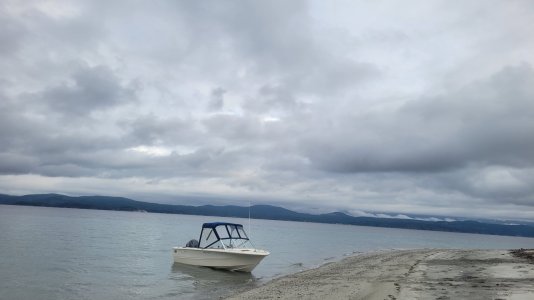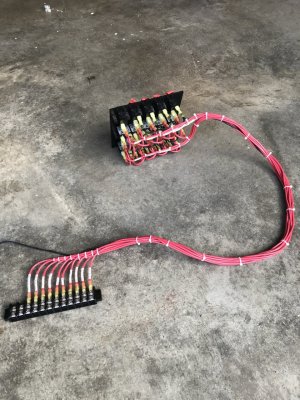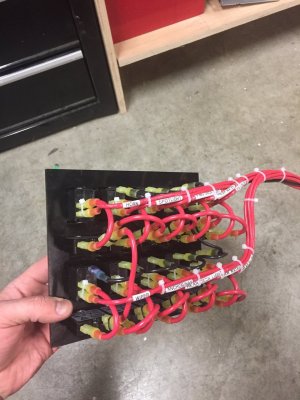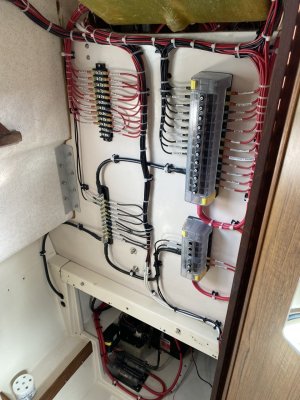Hey fellas
My 17.2 wiring looks like a dogs breakfasts. It mostly works, but I doubt for long. Connections are corroded, no batt switch, lights don't work, rigger wires don't look suffient for prawn puller, etc. I'd rather replace it all and avoid all the little issues.
This boat is only wired for one battery. It's served me fine but I'm wondering if there's reasons I really should be adding another (I can't find a reason myself)? If so where have others stuck the second batt in the 172? The existing batt is in the transom where I don't want the added weight. The only other potential would be the port sleeper which isn't ideal either. Boat lives on the trailer although I wouldn't mind leaving it in the drink for a month every spring.
I bought one of those 9" Garmin units from Cabela's on boxing week and have an existing hook unit I'll use as primarily a sounder. No radar. One pump. Brutus puller. Standard basic uniden radio. All these things mostly operate when the mains running (no overnighting, trolling, anchoring with electronics on, etc).
I haven't had any low voltage issues with the current setup (None I'm aware of anyhow), in the 10 uses since I bought the boat in September.
Power is a 2019 115 yam and a new merc 5ph sailpower as an auxiliary only. This is really a prawn and family boat so not planning on trolling, and if I did it would be on the yam.
So, any must have or nice to have items on the rewire that I might not think about but should add to a small boat like this?
Figured I'd run the float switch right off the battery so it's live with switches off. Is there a better way to keep float switch live?
Suggestions for best store in the Comox Valley for pricing on electrical parts?
Before I pickup wire: Wire size plan but open to suggestions
-8awg for riggers with 40amp inline fuses (less than 10' run)
-8awg for run to forward bus (2 gps units, wiper, led running lights, maybe add an aux plug)
-4 awg from bat to switch
-14awg for the small stuff and to extend the sailpower charging cables (Merc cables are only 5' and the run is 7')
It's a good little rig. Deserves a cleanup.
All thoughts and advice appreciated!
My 17.2 wiring looks like a dogs breakfasts. It mostly works, but I doubt for long. Connections are corroded, no batt switch, lights don't work, rigger wires don't look suffient for prawn puller, etc. I'd rather replace it all and avoid all the little issues.
This boat is only wired for one battery. It's served me fine but I'm wondering if there's reasons I really should be adding another (I can't find a reason myself)? If so where have others stuck the second batt in the 172? The existing batt is in the transom where I don't want the added weight. The only other potential would be the port sleeper which isn't ideal either. Boat lives on the trailer although I wouldn't mind leaving it in the drink for a month every spring.
I bought one of those 9" Garmin units from Cabela's on boxing week and have an existing hook unit I'll use as primarily a sounder. No radar. One pump. Brutus puller. Standard basic uniden radio. All these things mostly operate when the mains running (no overnighting, trolling, anchoring with electronics on, etc).
I haven't had any low voltage issues with the current setup (None I'm aware of anyhow), in the 10 uses since I bought the boat in September.
Power is a 2019 115 yam and a new merc 5ph sailpower as an auxiliary only. This is really a prawn and family boat so not planning on trolling, and if I did it would be on the yam.
So, any must have or nice to have items on the rewire that I might not think about but should add to a small boat like this?
Figured I'd run the float switch right off the battery so it's live with switches off. Is there a better way to keep float switch live?
Suggestions for best store in the Comox Valley for pricing on electrical parts?
Before I pickup wire: Wire size plan but open to suggestions
-8awg for riggers with 40amp inline fuses (less than 10' run)
-8awg for run to forward bus (2 gps units, wiper, led running lights, maybe add an aux plug)
-4 awg from bat to switch
-14awg for the small stuff and to extend the sailpower charging cables (Merc cables are only 5' and the run is 7')
It's a good little rig. Deserves a cleanup.
All thoughts and advice appreciated!
Attachments
Last edited:





